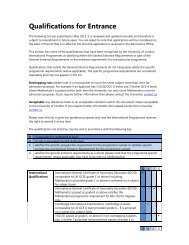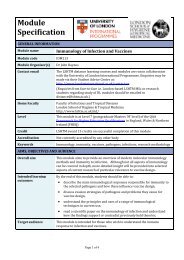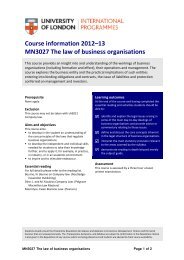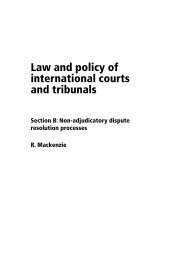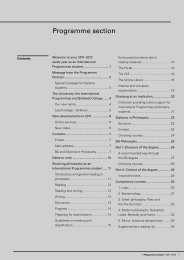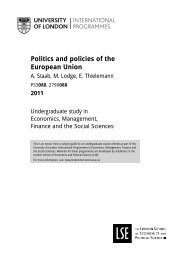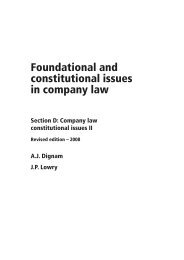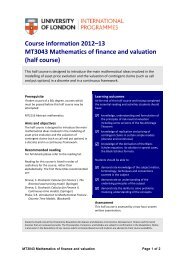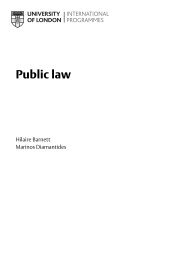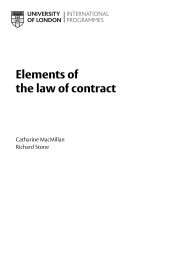Introduction to computer systems architecture and programming
Introduction to computer systems architecture and programming
Introduction to computer systems architecture and programming
You also want an ePaper? Increase the reach of your titles
YUMPU automatically turns print PDFs into web optimized ePapers that Google loves.
168 <strong>Introduction</strong> <strong>to</strong> <strong>computer</strong> <strong>systems</strong> <strong>architecture</strong> <strong>and</strong> <strong>programming</strong><br />
Please note that each chapter of the subject guide commences by identifying<br />
the appropriate chapters from these two textbooks. In instances where these<br />
textbooks are inadequate or simply do not cover a particular <strong>to</strong>pic, additional<br />
or supplementary reading is recommended.<br />
There is one further text which addresses all of the <strong>to</strong>pics in this course (Parts<br />
1 <strong>and</strong> 2), although not always in as much detail as you might like. Still, it is<br />
not an expensive text, <strong>and</strong> it is recommended that you add it <strong>to</strong> your personal<br />
Essential reading:<br />
Reynolds, C. <strong>and</strong> P. Tymann Schaum’s Outline of Principles of Computer Science<br />
(Schaum’s Outline Series). (New York: McGraw-Hill, 2008)<br />
[ISBN 9780071460514].<br />
Detailed reading references in this subject guide refer <strong>to</strong> the editions of the<br />
set textbooks listed above. New editions of one or more of these textbooks<br />
may have been published by the time you study this course. You can use a<br />
more recent edition of any of the books; use the detailed chapter <strong>and</strong> section<br />
headings <strong>and</strong> the index <strong>to</strong> identify relevant readings. Also check the virtual<br />
learning environment (VLE) regularly for updated guidance on readings.<br />
Further reading<br />
Please note that as long as you read the Essential reading you are then free<br />
<strong>to</strong> read around the subject area in any text, paper or online resource. You<br />
will need <strong>to</strong> support your learning by reading as widely as possible <strong>and</strong> by<br />
thinking about how these principles apply in the real world. To help you read<br />
extensively, you have free access <strong>to</strong> the VLE <strong>and</strong> University of London Online<br />
Library (see below).<br />
For more detail on the <strong>to</strong>pics of this course I would recommend the texts<br />
below.<br />
Computer <strong>architecture</strong>/organisation<br />
Comer, D.E. Computer Networks <strong>and</strong> Internets. (Upper Saddle River, N.J.: Prentice<br />
Hall, 2009) fifth edition [ISBN 9780136061274].<br />
Leiden, C. <strong>and</strong> M. Wilensky TCP/IP For Dummies. (Hoboken, N.J.: John Wiley &<br />
Sons, 2009) sixth edition [ISBN 9780470450604].<br />
Patterson, D.A. <strong>and</strong> J.L. Hennessy Computer Organization <strong>and</strong> Design: the<br />
Hardware/software Interface. (Burling<strong>to</strong>n, Mass.: Elsevier Morgan Kaufmann,<br />
2008) fourth edition [ISBN 9780123744937 (pbk)].<br />
Stallings, W. Computer Organization <strong>and</strong> Architecture, Designing for Performance.<br />
(Bos<strong>to</strong>n, Mass.: Pearson, 2010) [ISBN 9780135064177].<br />
Tanenbaum, A. Structured Computer Organization. (Upper Saddle River, N.J.:<br />
Pearson Prentice Hall, 2010) fifth edition [ISBN: 9780135094051(pbk)].<br />
Tanenbaum, A. Computer Networks. (Upper Saddle River, N.J.: Pearson, 2011) fifth<br />
international edition [ISBN 9780132553179].<br />
Programming in Java<br />
4<br />
Bell, D. <strong>and</strong> M. Parr Java for Students. (Harlow: Prentice Hall, 2010) sixth edition<br />
[ISBN 9780273731221(pbk)].<br />
Deitel, H.M. <strong>and</strong> P.J. Deitel Java: How <strong>to</strong> Program. (Upper Saddle River, N.J.; London:<br />
Pearson, 2010) eighth international edition [ISBN 9780131364837 (pbk)].<br />
Downey, A.B. How <strong>to</strong> Think Like a Computer Scientist, Java Version, Version 4.1<br />
(Free Software Foundation, 2008) http://greenteapress.com/thinkapjava/<br />
thinkapjava.pdf<br />
Horstmann, C.S. Java Concepts. (Hoboken, N.J.: John Wiley & Sons, 2010) sixth<br />
edition [ISBN 9780470509470 (pbk)].<br />
Liang, Y.D. <strong>Introduction</strong> <strong>to</strong> Java Programming. (Harlow: Pearson, 2010) brief<br />
version, eighth edition [ISBN 9780132473118 (pbk)].



